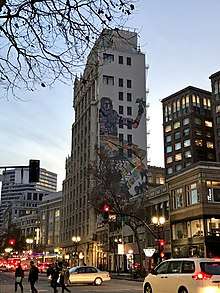Cathedral Building
The Cathedral Building (originally named the Federal Realty Building), built in 1914, was the first Gothic Revival style skyscraper west of the Mississippi River, located in Oakland, California.[1]
Federal Realty Building | |
  | |
| Location | 1615 Broadway, Oakland, California |
|---|---|
| Area | 0.1 acres (0.040 ha) |
| Built | 1914[1] |
| Architect | Benjamin Geer McDougall |
| Architectural style | Gothic Revival |
| NRHP reference No. | 79000467[2] |
| ODL No. | 70 |
| Significant dates | |
| Added to NRHP | January 2, 1979 |
| Designated ODL | 1983 |
Description and history

It is also called the "Wedding Cake" for its appearance, which resembles New York's Flatiron Building.[1] Its narrow, triangular form is a result of its location on Latham Square, where Telegraph Avenue branches off diagonally from Broadway. It was designed by architect Benjamin Geer McDougall.[1] It was developed by Brog Properties, a Downtown Oakland development firm who renovated the building for mixed residential and commercial units.[1] In June 2015, the United Nations Foundation commissioned Bay Area street artist Zio Ziegler to create a mural on the Cathedral Building's north-facing wall. The mural commemorates the signing of the United Nations Charter in San Francisco, California on June 26, 1945.[3]
The building was listed on the National Register of Historic Places on January 2, 1979.[2]
The third floor of the Cathedral Building was the setting for Cassius's apartment in the Oakland-based Boots Riley film Sorry to Bother You.[4]
References
- Mitchell, Eve (September 12, 2008), "Luxury condos rise in landmark Oakland skyscraper", Contra Costa Times
- "National Register Information System". National Register of Historic Places. National Park Service. July 9, 2010.
- Burke, Sarah (June 17, 2015), "Oakland's New International Icon: Last week, street artist Zio Ziegler partnered with the United Nations to erect a massive mural in downtown Oakland in the form of a figure releasing a dove", East Bay Express.
- Costley, Drew (2018-07-17). "The Black Panther bringing the spotlight to Oakland". SFGate. Retrieved 2018-12-21.

